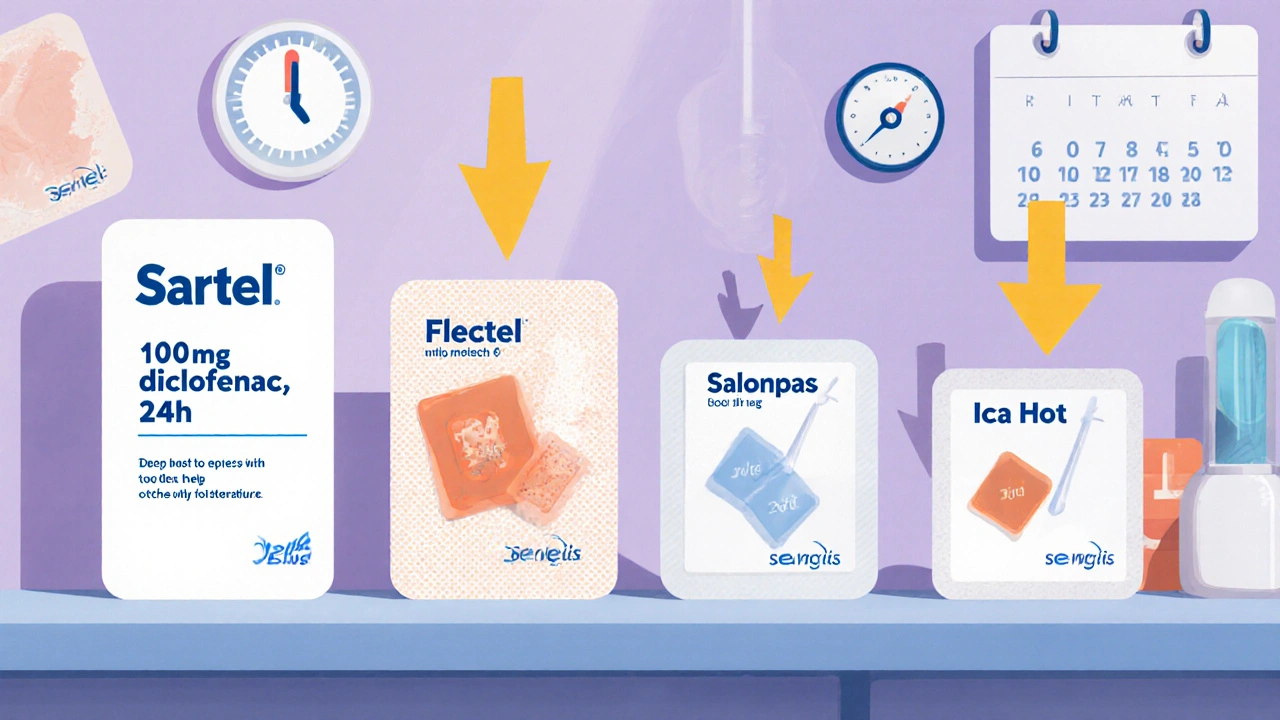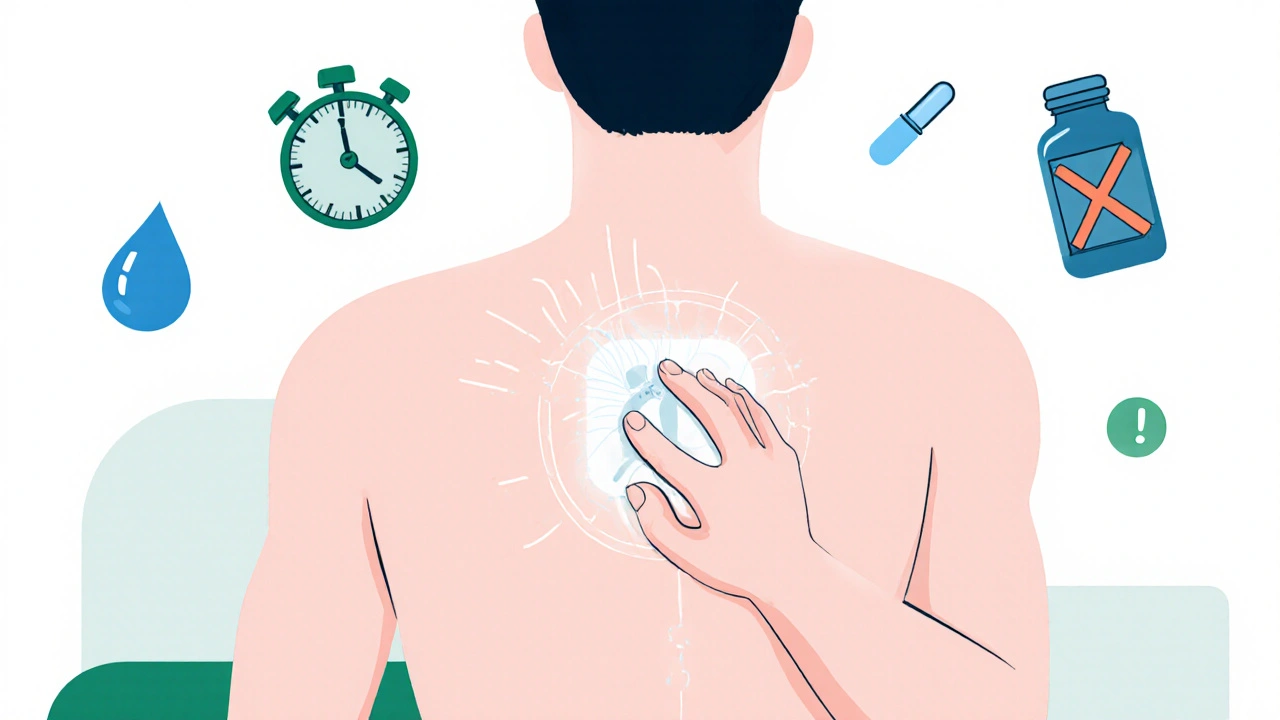Sartel isn’t a drug you swallow. It’s not a cream you rub in. It’s a thin, flexible patch you stick on your skin-right where it hurts. Developed in Turkey and now used across Europe and parts of Asia, Sartel delivers diclofenac, a powerful nonsteroidal anti-inflammatory drug (NSAID), directly to the source of your pain. No stomach upset. No pills to remember. Just targeted relief for muscles, joints, and tendons.
How Sartel Works
Sartel works by bypassing your digestive system. When you apply the patch to clean, dry skin over a painful area-like your lower back, shoulder, or knee-the active ingredient, diclofenac, slowly seeps through your skin and into the underlying tissue. This is called transdermal delivery. The patch holds about 100 milligrams of diclofenac, and over 24 hours, roughly 10% of that makes its way into your bloodstream. That’s enough to reduce inflammation and block pain signals locally, without flooding your whole body.
Unlike oral NSAIDs, which can irritate your stomach lining or raise blood pressure, Sartel keeps most of the drug where it’s needed. A 2023 study published in the European Journal of Pain showed that patients using diclofenac patches reported similar pain relief to those taking oral tablets-but with 70% fewer gastrointestinal side effects.
When to Use Sartel
Sartel is meant for short-term relief of mild to moderate pain caused by:
- Muscle strains or sprains
- Tendonitis (like tennis elbow or Achilles tendinitis)
- Osteoarthritis in knees, hands, or shoulders
- Back pain from overuse or poor posture
- Minor joint pain after physical activity
It’s not for deep joint pain from rheumatoid arthritis. It’s not for nerve pain like sciatica unless it’s caused by inflammation. And it won’t fix a broken bone. Think of it as a targeted tool-not a cure-all.
How to Apply Sartel Correctly
Using Sartel wrong can mean no relief-or worse, skin irritation. Here’s how to do it right:
- Wash and dry the area where you’ll place the patch. No lotions, oils, or sweat.
- Peel off the backing carefully. Don’t touch the sticky side with your fingers.
- Press the patch firmly onto clean skin. Smooth it out to avoid air bubbles.
- Leave it on for exactly 24 hours. Don’t cut it, fold it, or reapply it.
- After removing, wash the area with soap and water. Wait at least 12 hours before applying another patch.
Don’t use it on broken, burned, or rash-covered skin. Avoid using it near your eyes, mouth, or genitals. If you’re sweating heavily or showering often, the patch might loosen. That’s normal-but if it falls off completely, don’t re-stick it. Use a new one.
Side Effects and Risks
Most people tolerate Sartel well. But not everyone.
The most common issue? Skin reactions. About 1 in 10 users report mild redness, itching, or dryness where the patch was applied. That usually goes away within a day. If it gets worse-blistering, swelling, or a rash that spreads-stop using it and see a doctor.
Less common but serious: allergic reactions. Signs include trouble breathing, swelling of the face or throat, or hives. These are rare but need emergency care.
Because Sartel still delivers diclofenac into your system, it carries the same risks as oral NSAIDs-just lower. If you have a history of stomach ulcers, heart disease, kidney problems, or are over 65, talk to your doctor before using it. Pregnant women, especially in the third trimester, should avoid it. Breastfeeding mothers should check with their doctor too.
Sartel vs. Other Pain Patches
You’ve probably seen other patches on the shelf: Salonpas, Flector, or even menthol-based ones like Icy Hot. Here’s how Sartel stacks up:
| Product | Active Ingredient | Duration | Strength | Best For |
|---|---|---|---|---|
| Sartel | Diclofenac sodium | 24 hours | High (100 mg) | Deep muscle/joint inflammation |
| Flector | Diclofenac epolamine | 12 hours | Medium (1.3% concentration) | Short-term acute pain |
| Salonpas | Menthol + Methyl salicylate | 8-12 hours | Low | Mild surface pain, temporary relief |
| Icy Hot | Menthol + Camphor | 4-6 hours | Very low | Temporary distraction from pain |
Sartel is stronger than menthol patches and lasts longer than Flector. If your pain is deep, persistent, and tied to inflammation, Sartel is the most effective patch you can buy without a prescription in many countries.

Who Should Avoid Sartel
Sartel isn’t for everyone. Skip it if you:
- Are allergic to aspirin or other NSAIDs
- Have had stomach bleeding or ulcers
- Have severe heart failure or uncontrolled high blood pressure
- Are in your third trimester of pregnancy
- Are under 18 (unless directed by a doctor)
- Are already taking other NSAIDs (like ibuprofen or naproxen)
Also, don’t combine Sartel with heat wraps, heating pads, or sunlamps. Heat increases how much diclofenac your skin absorbs-and that raises your risk of side effects.
Where to Buy Sartel
In the UK, Sartel is available over the counter at most pharmacies-no prescription needed. Look for it near other pain relief patches. Brands like Boots, Superdrug, and independent pharmacies usually stock it. A pack of 5 patches costs around £12-£16. Online pharmacies sell it too, but make sure they’re registered with the UK’s General Pharmaceutical Council (GPhC). Avoid sites offering it at half price-they might be selling counterfeit versions.
In the EU, it’s widely available in Germany, France, Spain, and Turkey. In the US, diclofenac patches are sold under the brand Flector, but Sartel itself isn’t approved for sale there.
Real Results: What Users Say
People who’ve tried Sartel often describe it as a game-changer.
“I’ve had chronic lower back pain for years from sitting at a desk,” says Mark, 52, from Bristol. “I used to take ibuprofen every day. My stomach was never happy. After trying Sartel, I only use it when I’m really stiff. No more bloating. No more nausea. Just relief where I need it.”
Another user, Lena, 67, says: “I have osteoarthritis in my knee. Walking to the shop used to hurt. I put Sartel on before I go out. It doesn’t make the pain vanish-but it lets me move without wincing. That’s enough.”
These aren’t ads. These are real experiences from people who’ve found a practical solution that fits their life.
How Long Until It Works?
Don’t expect instant results. Sartel isn’t like a painkiller you swallow-it’s a slow, steady release. Most people feel a noticeable difference after 8-12 hours. Full effect usually takes 24 hours. That’s why it’s designed to be worn overnight or during the day while you’re active.
If you don’t feel better after 3 days of consistent use, stop. It might not be the right solution for your pain. Talk to your doctor. You might need physical therapy, an injection, or a different treatment.

Storage and Shelf Life
Keep Sartel patches in their original packaging. Store them at room temperature-between 15°C and 25°C. Avoid damp places like bathrooms. Don’t freeze them. Each patch has an expiration date printed on the pack. Don’t use one past that date. The adhesive weakens, and the drug might not work as well.
Can You Use Sartel Long-Term?
Sartel is not meant for daily, continuous use over months. The manufacturer recommends using it for no more than 7-14 days at a time. If your pain lasts longer, it’s a sign something deeper is going on. Chronic pain needs diagnosis-not just masking.
Think of Sartel like a bandage for inflammation. It helps you get through the rough patch so you can start rehab, stretch, strengthen, or adjust your habits. It’s a bridge-not a permanent fix.
What to Do If You Miss a Dose
There’s no such thing as a missed dose with Sartel. You apply it once every 24 hours. If you forget, apply it as soon as you remember-but don’t double up. Skip the missed application and go back to your regular schedule. Never wear two patches at once. That increases your risk of side effects without giving you more relief.
Is Sartel the same as Voltaren gel?
Sartel and Voltaren gel both contain diclofenac, but they’re delivered differently. Sartel is a patch that releases the drug slowly over 24 hours. Voltaren gel is rubbed into the skin and works faster but lasts only 4-6 hours. The patch is better for deeper, longer-lasting pain. The gel is better for surface pain or if you need to treat multiple small areas.
Can I use Sartel with other painkillers?
You can use Sartel with paracetamol (acetaminophen), since it works differently. But avoid combining it with other NSAIDs like ibuprofen, naproxen, or aspirin. Taking more than one NSAID at a time increases your risk of stomach bleeding, kidney damage, and high blood pressure-even if one is topical.
Does Sartel help with nerve pain?
Sartel is designed for inflammatory pain-like sore muscles or arthritic joints. It doesn’t work well for true nerve pain, such as diabetic neuropathy or sciatica caused by a pinched nerve. For those, you need medications like gabapentin or pregabalin, or physical therapy. Sartel might help if the nerve pain is caused by swelling around the nerve, but it’s not the first choice.
Can I exercise while wearing Sartel?
Yes. Sartel is designed to stay in place during movement. Many people wear it while walking, gardening, or doing light workouts. Avoid intense sweating or swimming, as that can loosen the patch. If it peels off, don’t reapply it-use a new one.
Why does my skin feel numb after removing Sartel?
That’s normal. Diclofenac can temporarily reduce sensation in the area where the patch was applied. It’s not damage-it’s just the medication working. The feeling usually returns within a few hours. If numbness lasts more than 24 hours or spreads, contact a doctor.
Final Thoughts
Sartel isn’t magic. But for millions of people with localized pain, it’s one of the most reliable, low-risk tools they’ve found. It doesn’t replace exercise, physiotherapy, or good posture-but it gives you the space to do those things without being held back by pain.
If you’ve been relying on pills that upset your stomach, or creams that don’t last, Sartel might be the quiet upgrade you didn’t know you needed. Just remember: apply it right, give it time, and don’t use it as a crutch. Let it help you move again-then take the next step toward real healing.
